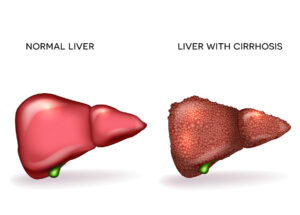Hepatitis C is a common viral liver infection and hepatitis C can lead to cirrhosis of the liver. Recently a review article was published.
Heavy alcohol abuse can also lead to chronic inflammation of liver cells. On the long term this leads to extensive scar tissue in the liver, called liver cirrhosis.
Lack of symptoms of hepatitis C
Contrary to hepatitis A and B, which are very symptomatic early on during the disease, symptoms are often not present with hepatitis C for many years. A screening blood test shows right away whether or not you have hepatitis C.
Treatment of hepatitis C
When the physician makes a diagnosis of hepatitis C, it is important that the patient sees a gastroenterologist who specializes in the treatment of hepatitis C.
Hepatitis C therapy consists of the use of direct-acting antivirals (DAA). This cures 99% of hepatitis C cases within 6 months. In the past interferon therapy was given, but this had a lot of side effects and lower cure rates.
Chronic hepatitis
Chronic hepatitis develops in about 80% of hepatitis C patients. About 20% of patients with chronic hepatitis develop cirrhosis of the liver from the chronic inflammation, but it often takes several decades to develop to this stage. Here is a picture of a cirrhotic liver. A patient with this type of liver often has jaundice, has ascites( an accumulation of fluid) in the abdomen and portal hypertension with periumbilical varicose veins as well as gynecomastia. Once cirrhosis has developed, the patients are at a higher risk to develop cancer of the liver later in life. In the past corticosteroids were thought to be useful, but now we know that they are not advisable for the treatment of chronic viral hepatitis. Corticosteroids enhance viral multiplication. Physicians used interferon treatment three times per week. This has led to remissions in about 1/3 of hepatitis B patients.
Higher cure rates with ribavirin and direct-acting antivirals
Hepatitis C has now much higher cure rates than in the past. Physicians thought then that a 50 % response rates in terms of suppression of inflammation in hepatitis C patients was “good”. Several developments that occurred were instrumental in this improvement:
1) The response rate improved with the addition of ribavirin, an antiviral drug that the doctor ordered twice per day.
2) With the arrival of direct-acting antivirals (DAA) interferon treatment has become obsolete, as with DAA therapy cure rates of up to 99% can be achieved in only 6 months. Also, the side effects are much less than they were with interferon treatment.
Transition from chronic hepatitis C to cirrhosis of the liver and liver cancer
There is an association between chronic inflammation and hepatitis C. This in turn causes scarring around the liver cells, a condition termed cirrhosis of the liver. If the virus is not eradicated with direct-acting antivirals (DAA), liver cancer can develop as the end stage. You can see from that how urgent it is to eradicate the hepatitis C virus as it is the root of developing chronic inflammation of the liver, cirrhosis of the liver and liver cancer.
Conclusion
Hepatitis C is very common. According to the CDC 1% of the US population has hepatitis C; 23.4 million in the US have active hepatitis C infection. Only about 15% experience spontaneous healing of hepatitis C. This means that 85% develop chronic hepatitis. Over the years the medical profession has learnt that chronic hepatitis eventually turns into cirrhosis of the liver, which often leads to premature death. But cirrhosis of the liver can turn into liver cancer, an even deadlier disease. With the introduction of direct-acting antivirals (DAA) a few years ago hepatitis C is now curable in 99% of cases within only 6 months of treatment. The hepatitis C patient needs to seek medical advice and follow the DAA protocol. This has much fewer side effects than interferon treatment had in the past, a treatment, which is now obsolete.
Part of this was published previously here.







